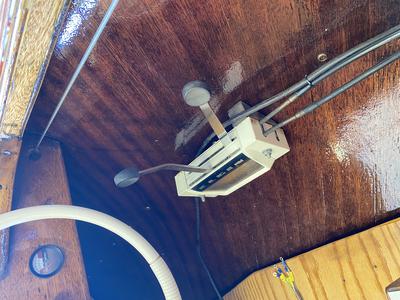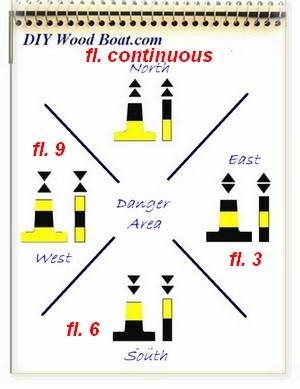Forecasting
Terms and the Beaufort Scale.
The
Beaufort
Scale is just one of the
forecasting terms still in use by marine forecasters
today.
This scale and a number of other terms are used to convey specific,
concise,
meanings to help sailors estimate the wind speed and strength, sea
state and
forecast predictions
The Beaufort
Wind Force Scale.
The Beaufort
Scale was created by Admiral
Sir Francis Beaufort in 1805, his wind strength and sea state numbers
are among
the forecasting terms still in use today.
|
Beaufort
|
Wind Speed Kts)
|
Wind Speed km/hour
|
Sea State
|
|
0 / Calm
|
0-1
|
0
|
Sea like a mirror, Wave Height 0 ft.
|
|
1 / Light Air
|
1-3
|
2-5
|
Ripples but without foam crests Wave Height
> 0.25 ft.
|
|
2 / Light Breeze
|
4-6
|
6 – 12
|
Small wavelets. Crests have a glassy appearance and
do not break,
Wave Height: >0.5 ft
|
|
3 / Gentle Breeze
|
7-10
|
13 – 20
|
Large wavelets. Some whitecaps Wave Height
>2 ft
|
|
4 / Moderate Breeze
|
11-16
|
21 – 30
|
Small waves, Fairly frequent white caps, Wave
Height >4 ft.
|
|
5 / Fresh Breeze
|
17-21
|
31 – 40
|
Moderate waves, many white caps, Chance of some
spray, Wave Height
>6 ft.
|
|
6 / Strong Breeze
|
22-27
|
41 - 50
|
Large waves begin to form; the white foam crests
are more extensive
everywhere. Probably some spray, Wave Height >10 ft.
|
|
7 / Near Gale
|
28-33
|
51-61
|
Sea heaps up and white foam from breaking waves
blown in streaks in
the direction of the wind. Wave Height >14 ft.
|
|
8 / Gale
|
34-40
|
62-74
|
Moderately high waves of greater length, Crests
begin to break into
spindrift, In the tropics categorized as a Tropical Storm, Wave
Height >18 ft.
|
|
9 / Strong Gale
|
41-47
|
75-89
|
High waves. Dense foam streaks along the direction
of the wind.
Crests of waves begin to topple and roll over. Spray may affect
visibility, Wave Height >23 ft.
|
|
10 / Storm
|
48-55
|
90-103
|
Very high waves with long overhanging crests. Foam
is blown in dense
white streaks, The surface of the sea takes on a white appearance.
The tumbling of the sea becomes heavy, Visibility affected. Wave
Height >29 ft.
|
|
11 / Violent Storm
|
56-63
|
104-119
|
Exceptionally high waves, The sea is completely
covered with long
white patches of foam lying along the direction of the wind, Wave
crests are blown into froth, Visibility, Wave Height >37 ft.
|
|
12 / Hurricane
|
64-71
|
120+
|
The air is filled with foam and spray. Sea
completely white with
driving spray. Visibility very seriously affected. Equal to a
Category 1 Hurricane on the Saffir-Simpson Scale, Wave Height 45 ft.
|
Wind
descriptions.
Marine Weather
Forecasting Terms used to
describe how the wind is forecast to behave.
|
Direction
|
This is always the direction from which wind is
blowing.
|
|
Wind becoming cyclonic
|
A rapid change in direction, usually associated
with frontal system
|
|
Veering
|
Wind direction changing in a clockwise direction,
eg. S to SW to W
etc.
|
|
Backing
|
Wind direction changing in an anti-clockwise
direction, eg. E to NE
to N etc.
|
Forecasting Terms for Visibility.
These
Forecasting Terms are used to
describe viability quite specifically.
|
Fog
|
Down to less than 1000 Meters, 0.6 nautical miles.
|
|
Poor
|
Between 1000 Meters and 2 nautical miles
|
|
Moderate
|
Between 2 and 5 nautical miles
|
|
Good
|
More than 5 nautical miles
|
Time
periods.
|
Imminent
|
Expected within 6 hours of time of issue or
broadcast.
|
|
Soon
|
Expected within 6 to 12 hours of time of issue or
broadcast.
|
|
Later
|
Expected more than 12 hours from time of issue or
broadcast.
|
Pressure
tendency.
|
Rising / Falling More Slowly.
|
The pressure is rising or falling at a slower rate
through the
previous three hours.
|
|
Rising / Falling slowly.
|
A pressure change of 0.1 to 1.5 0 hPa/mb in the
preceding three
hours.
|
|
Rising / Falling.
|
Pressure change of 1.6 to 3.5 0 hPa/mb in the
preceding three hours.
|
|
Rising / Falling quickly.
|
Pressure change of 3.6 to 6.0 0 hPa/mb in the
preceding three hours.
|
|
Rising / Falling V. Rapidly.
|
Pressure change of more than 6.0 hPa/mb in the
preceding three hours.
|
|
Now Rising / Falling.
|
Pressure has been Rising / Falling or steady in the
preceding three
hours, but at the time of observation was definitely beginning to
Rise / Fall.
|
Speed
of pressure systems
movement.
These Forecasting Terms are used to describe the predicted
movements of
pressure systems.
|
Slowly
|
Moving at less than 15 Knots
|
|
Steadily
|
Moving at 15 to 25 Knots
|
|
Quickly
|
Moving at 25 to 35 Knots
|
|
Rapidly
|
Moving at 35 to 45 Knots
|
|
Very Rapidly
|
Moving at more than 45 Knots
|









